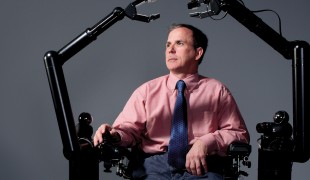- 9049
- 444
- 14
- 36
- 0
- Help Ukraine
About the solution
“I wanted to get back to doing the activities I loved (mainly motocross and snowmobile racing) , but I soon found out there was nothing that would really allow me to ride the way I did before my amputation. With my knowledge and experience of fabrication, the experience of tuning suspension on my race equipment and my unwillingness to compromise I set out to create what I needed. After nearly two years of development I have come up with a knee unit that is versatile enough to handle many different action sports and has helped me win multiple ESPN X Games medals in the adaptive motocross and snow cross events. In my many years of racing as a professional I’ve learned it takes a few key components to be successful; Support from the people around you, a whole lot of determination and the right tools for the job," he explained.
Mike was always in shops, and was passionate about mechanics since he was a boy. So with the help of some friends, he started designing and prototyping.
“I didn’t feel there was equipment available that would work up to my high standards, so me being a problem-solver, I took on the project of building my own leg”, the inventor expressed.
After Mike compete at his first adaptive sporting event he soon realized that many other amputees could benefit from the equipment he was working on.
In 2010, he started his own company called BioDapt. The company designs, manufactures and distributes high performance lower limb prosthetic components used for action sports and other similar activities. The goal is to manufacture the highest quality and highly versatile components that allow amputees to participate in sports and activities.
More info: http://www.biodaptinc.com
Adapted from: http://bit.ly/2tsLzs8
https://youtu.be/B1JWYnNUcvo
This solution shall not include mention to the use of drugs, chemicals or biologicals (including food); invasive devices; offensive, commercial or inherently dangerous content. This solution was not medically validated. Proceed with caution! If you have any doubts, please consult with a health professional.
DISCLAIMER: This story was written by someone who is not the author of the solution, therefore please be advised that, although it was written with the utmost respect for the innovation and the innovator, there can be some incorrect statements. If you find any errors please contact the patient Innovation team via info@patient-innovation.com
-
-
450
-
0
-
8538

Double amputee creates prosthesis for snowboarding and dancing
WALKING WITH A WALKING AID: Walking with a walking aid
Snowboarding
Dancing
Limb Amputation
Meningitis
Bacterial Infection
Prosthesis
Assistive Daily Life Device (to help ADL)
Difficulty walking or moving
Gait abnormalities (e.g., walking difficulties, unsteady gait)
Muscle weakness
Stiffness or rigidity (difficulty moving)
Limited range of motion
Recurrent fevers
Difficulty standing from a seated position
Difficulty fighting off infections
Changes in appetite or weight
Swelling or inflammation
Restoring mobility
Replacing lost limbs
Promoting inclusivity and social integration
General and Family Medicine
Infectious Diseases
Neurology
Orthopedics
United States
-
-
-
140
-
0
-
1799

Teacher Alex Truesdell is Transforming Lives: Adaptive Design Association Revolutionizes Disability Solutions
CAREGIVING
Drawing
Painting
Playing
BODY BALANCE: Maintaining body balance
(SELF)-CARE: DRINKING: Drinking independently.
(SELF)-CARE: EATING: Eating independently.
MOVING IN A WHEELCHAIR: Moving using a wheelchair.
Playing an instrument
Studying
Blindness
Hand Deformity
Neuromuscular Disorders
Assistive Daily Life Device (to help ADL)
Walking Aid (wheelchair/walker/crutches)
Restoring mobility
Replacing lost limbs
Enhancing health literacy
Promoting self-management
Promoting inclusivity and social integration
To improve Treatment/Therapy
Preventing (Vaccination, Protection, Falls, Research/Mapping)
Raise awareness
Caregiving Support
General and Family Medicine
Internal Medicine
Orthopedics
Pediatrics
Physical Medicine and Rehabilitation
United States
-
-
-
301
-
0
-
5554

Paralyzed man designs innovative wheelchairs
CAREGIVING
MOVING IN A WHEELCHAIR: Moving using a wheelchair.
Grip
Rubgy
Basketball
Paralysis
Cervical spinal cord injury/Tetraplegia
Assistive Daily Life Device (to help ADL)
Assistive Technology access
Walking Aid (wheelchair/walker/crutches)
Restoring mobility
Replacing lost limbs
Promoting self-management
Promoting inclusivity and social integration
Recovering from Traumatic Injuries
Preventing (Vaccination, Protection, Falls, Research/Mapping)
Caregiving Support
Neurology
Orthopedics
Physical Medicine and Rehabilitation
United States
-
 en
en